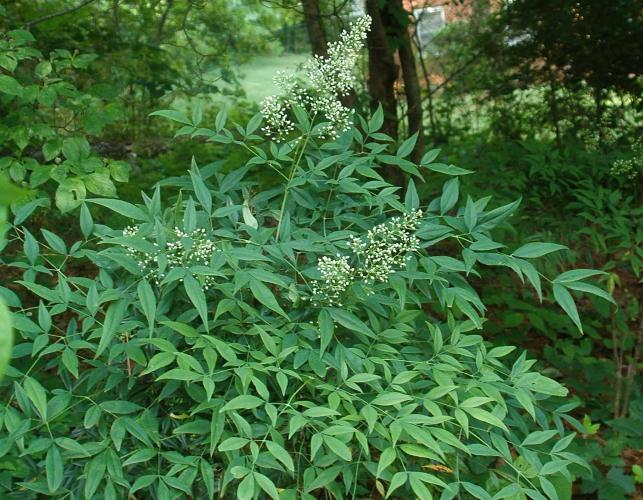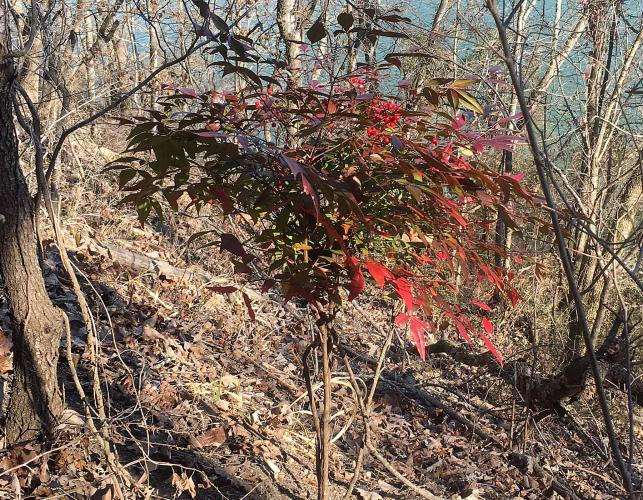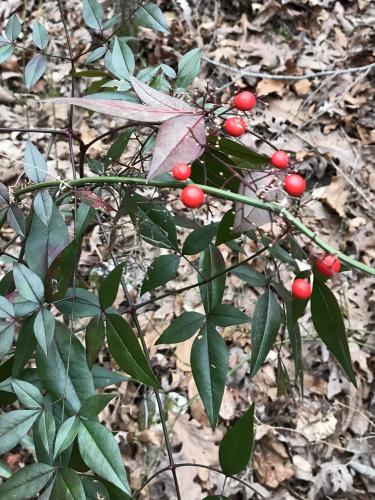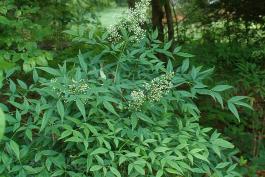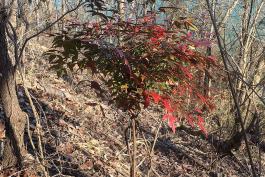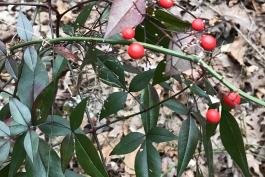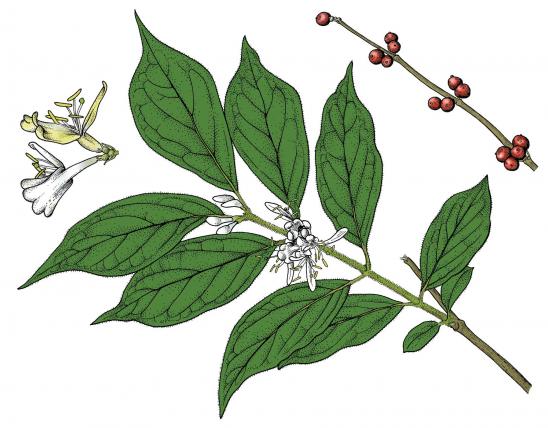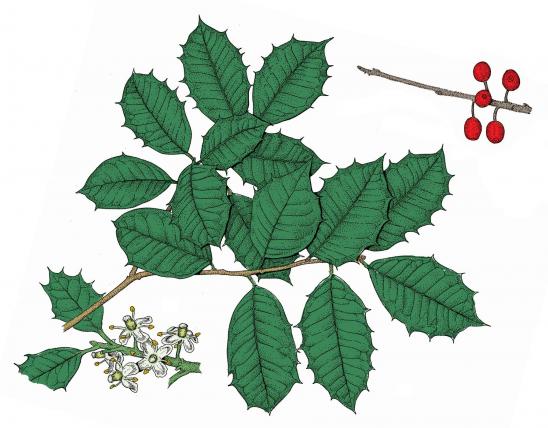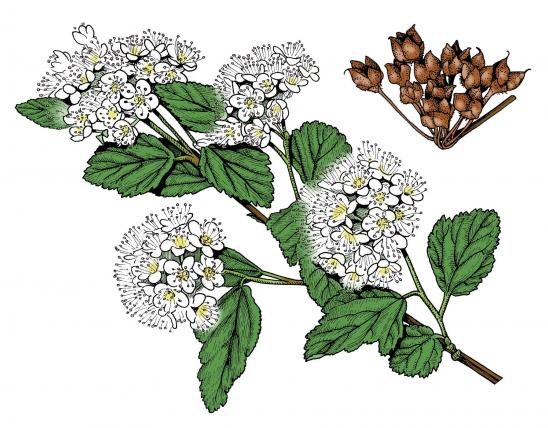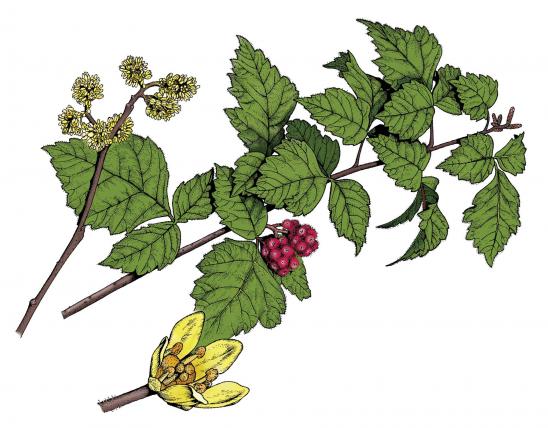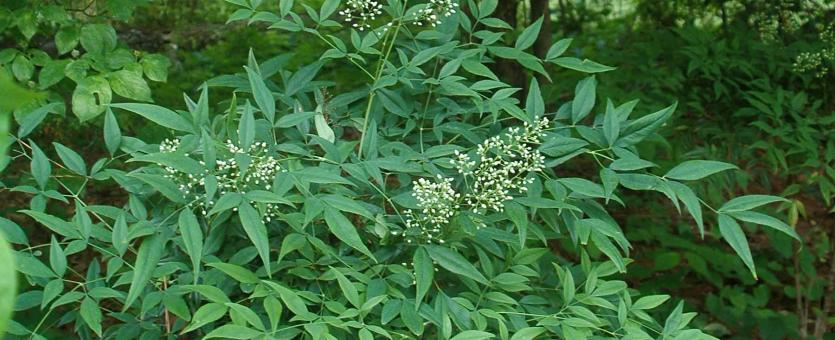
Heavenly bamboo is an evergreen shrub with compound, somewhat lacy leaves and sprays of red berries that persist through the winter. Its multistemmed, canelike clumps make it superficially resemble bamboo.
Leaves are alternate, large, two- or three-times compound, mostly clustered toward the top of the woody stems. Young foliage is often pinkish, turning soft light green. Except in the coldest temperatures (below 10F), the leaves don’t drop; they stay green all winter and are often tinged with red. Individual leaflets are 1–2 inches long, lance-shaped or oval, with a pointy tip.
Flowers in early summer with erect, 6–12 inch long clusters of tiny pink to white flowers. The resulting clusters of shiny, red, two-seeded berries persist from fall to spring.
Many cultivars are available having more or less reddish leaves, smaller overall size, and so on. These are currently very popular in garden centers. We urge you to try a native-species alternative.
Similar species: The shoots superficially resemble those of bamboo, but true bamboo is a grass and does not have compound leaves.
Height: up to 3–7 feet.
The first documented escape of it in Missouri was in the Springfield area. It is exceedingly popular for landscaping and is cultivated statewide. It has invaded natural habitats throughout the southeastern U.S., forming dense thickets in forests. In Tennessee, for example, it has covered about 10,000 acres of national forest lands alone.
Habitat and Conservation
Heavenly bamboo will grow in full sun to shade. It prefers fairly rich soil but does not thrive in sand. It invades and thrives in the forest understory and along forest edges. Heavenly bamboo is hardly “heavenly” when it comes to its negative effects on our native plant and animals. It can form thickets, and its ever-present leaves shade out the native wildflowers below. All parts of the plants are toxic. The berries contain high levels of cyanide and can poison wild birds and other animals, including pets. It has few pests or diseases, and wildlife don’t seem to eat it.
Status
Invasive. This plant is native to Asia. It was brought to America as an ornamental in the early 1800s. Like many other invasive plants, there was a considerable lag time before it exhibited its invasive potential. Researchers have been tracking the spread of heavenly bamboo as an invasive species across the southeastern United States. It has already become a problem in Arkansas and Tennessee. So far in Missouri, the outbreaks are minimal, but it seems only a matter of time before heavenly bamboo becomes a big problem in our woodlands and other natural areas. Early detection and elimination are the key to minimizing the impact of any invasive species.
Life Cycle
Eradication of heavenly bamboo can be difficult. Learning how it spreads helps you understand what does and doesn’t work. Heavenly bamboo spreads vigorously from its roots (much like true bamboo). Also, birds eat the berries, then deposit the undigested seeds practically anywhere, far from the parent plant. Once sprouted, heavenly bamboo may persist as small seedlings for several years before reaching maturity. As the plant grows, its root system does, too. If you try to pull up a plant and even a small piece of root remains in the soil, it will resprout from that broken root piece. Cutting down or burning the top of an established heavenly bamboo plant invariably results in its resprouting from the stump. Herbicides typically work best on small plants or on young resprouts. Depending on the situation, controlling this plant can include a combination of prescribed burning, hand pulling of seedlings, cutting, and herbicide treatments.
Control
Human Connections
Having a toxic, exotic plant get out of control in our state isn’t good news for pets or livestock. Apparently there have been no reported poisonings of humans. If you have this plant, we recommend getting rid of it (see above for links to control pages). If you do plant it, make sure you have selected a sterile variety. Best, don’t plant it in the first place: Choose a native alternative. Try American beautyberry, Virginia sweet-spire, Carolina allspice, New Jersey tea, wahoo, black chokeberry, fragrant sumac, or ninebark.
Ecosystem Connections
Forest and woodland natural communities are most threatened by the invasion of this species. It will form dense thickets that outcompete native vegetation, limiting food sources for wildlife. The toxic cyanide in the berries has been documented to kill birds that gorge themselves on them (such as cedar waxwings) when other types of berries are scarce. Most birds, however, consume only a few of the berries at a time and are largely unharmed. The seeds are thus readily moved far and wide from the original plant.
